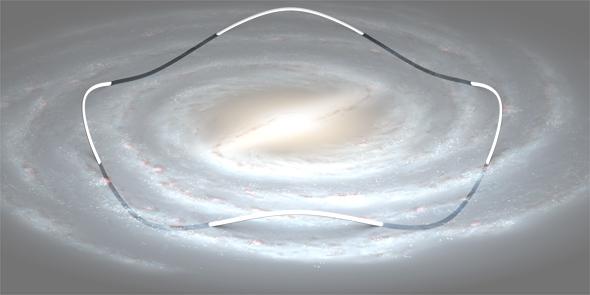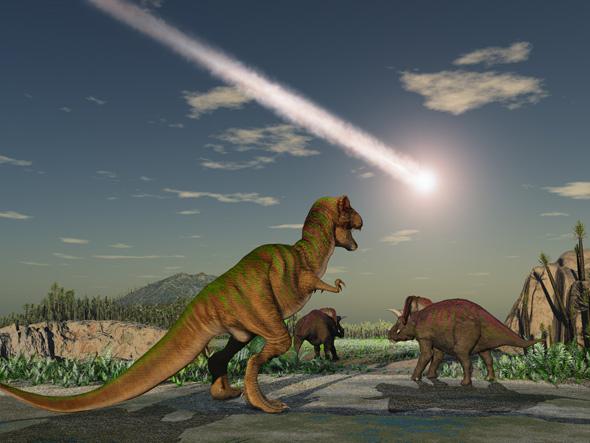What killed the dinosaurs?
Well, we know it was an enormous impact from an asteroid or comet, something about 10 kilometers (six miles) in diameter, that slammed into the Gulf of Mexico about 65 million years ago. But was this a random accident? Or was there an underlying cause, some natural event that nudged that rock inward from the depths of space, toward Earth?
It’s not an entirely crazy question. There has been a lot of speculation and research into the idea that mass extinctions on Earth are periodic over tens of millions of years; that is, come in rough but definite intervals. We know of a half dozen global extinctions in the Earth’s past, and many more smaller ones. The fossil record is difficult to interpret, though, and getting solid numbers elusive. Even the very idea of some periodicity to mass extinctions is not well-understood. Given that, it’s most likely the dinosaur-killer was a one-off, a singular event not associated with any cycle.
Bear that in mind, please, for the rest of this article.
If there is some periodicity to extinction events (which is not established), then this implies an extraterrestrial cause, because cycles that long are easier to come by when you’re talking cosmic origins. It’s also easier to get the sort of catastrophic scale needed from astronomical phenomena: nearby supernovae, blasts of intergalactic radiation, and of course giant asteroid impacts.
That last seems the most likely, since we know they do happen, and of course we can point to the dinosaurs as proof. This area is fraught with problems, though! The biggest is that craters erode over time, making it hard to find and examine older ones; after a few million years smaller craters disappear, and even big ones play hard to get after a few hundred million.
This means the number of craters on Earth is low, and therefore getting good statistics difficult. While it’s tempting to link asteroids to mass extinctions, a recent study showed no such periodic nature to impact events. So that’s another problem.
Still, it’s tempting to look at cosmic causes. Even if we don’t have the solid data now, by looking at possible causes we might get a hint at where and how to look for data.
With this in mind, physicists Lisa Randall and Matthew Reece came up with an interesting idea: dark matter. This is invisible stuff that we know exists but don’t know much about. Whatever it is it has mass, because we see its gravitational effects on individual galaxies as well as clusters of them, and it also plays into the structure of the overall Universe as well.
Dark matter doesn’t play well with normal matter, which is one of the reasons why we know so little about it. It doesn’t appear to interact with it very much at all; particles of dark matter could pass right through you and you’d never know. But it’s possible that dark matter interacts with itself, and if that’s the case, things get interesting.
We think there is a spherical dark matter halo surrounding our galaxy. Over time, collisions between dark matter particles (and other processes) could rob some of those particles of energy, and they’d fall in toward the galaxy itself. They’d eventually form a thin disk, much like the disk of the Milky Way itself.

Drawing by Chris Setter
Here’s where it gets fun. The Sun orbits the center of the galaxy, but it doesn’t do so in a flat circle. It bobs up and down, a bit like a cork in water, as it goes around. The gravity of the disk of stars in our galaxy tugs on it, so when it goes up, above the disk, it feels a force downward, and vice versa.
It passes through the galactic plane about every 35 million years or so, and that so happens to be one of the periods proposed for mass extinctions. Provocative! Maybe the gravity of the galaxy itself nudges giant comets or asteroids in the outer solar system in toward the Sun, sending them on a collision course for Earth.
It turns out there isn’t enough normal matter to do this. But if you add in that dark matter disk, Randall and Reece say, it might be enough to do the trick. They go through the math, and find that it’s just possible this would work, though statistically speaking it’s not a huge effect.
So how viable is this idea? Well, we don’t know if extinctions are periodic, we don’t know if impacts are either, we can’t say the impact that erased dinosaurs and 75 percent of other species off the planet was part of any cycle, and the idea proposed by the physicists is speculative (and based on a hypothetical form of dark matter) and doesn’t have a very strong effect.
So I’m on the “probably not viable” side of this.
And I want to be clear: The physicists know this too! They took great pains to point all this out in their paper, and I think that’s great. Heck the very first line of their abstract says, “Although statistical evidence is not overwhelming, possible support for an approximately 35 million year periodicity in the crater records on Earth could indicate a nonrandom underlying enhancement of meteorite impacts at regular intervals.”
You could argue that this is a paper about an answer searching for a question. That case can be made, but I don’t have too big a problem with it. Basically, the paper is more of an exercise of extrapolation, an experiment to take some physics and see what you get, what’s possible, and perhaps make some predictions based on that. That’s fine! It’s a good idea to put that kind of edgy stuff out there so people see it; that way it can be poked at, prodded, and see what happens. Maybe it’ll fall apart (for example: If dark matter is nudging space rocks toward Earth, shouldn’t we see multiple impact events all around the same time?). Maybe someone will detect some observational evidence to support it. Either way, it’s always good to keep in mind this is speculation based on scanty (but not unscientific) evidence.
That of course has not stopped some media from running away with the idea. A search on “dark matter dinosaurs” will yield some sober analysis (the original article in Nature sums it up pretty well), as well as some breathless articles making it seem like this is fact (cough cough Daily Mail cough cough—a rag I wouldn’t wrap moldy fish in, because it would insult the fish—and in that article they only discuss the doubts about the research at the very end).
Science on the fringe is an interesting thing. By its very nature we don’t have a lot of evidence one way or another, just some interesting observations. So what do you do? Well, coming up with ideas that make predictions is a pretty good start. It allows a direction for research, to look for evidence that supports or contradicts the prediction. That’s what Randall and Reece have done. They’ve acknowledged that, and so in my opinion we’re all good here. Science has done what it’s supposed to do, and the process is ongoing. It’ll take time to figure this all out.
The media, for their part, need to understand this and not overly play it up or dismiss it out of hand. Like I said, this is pretty speculative and based on shaky stuff. But in the meantime, this is fun! The loose boundaries here allow scientists’ imagination to soar a bit, and it’s entirely possible one of them will see a clear path ahead. Most ideas will fail, of course, but sometimes the only way to find the right one is to try as many as possible. We’ll see.
